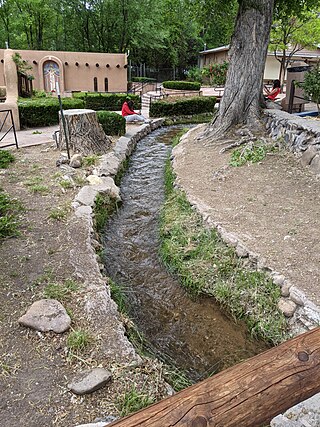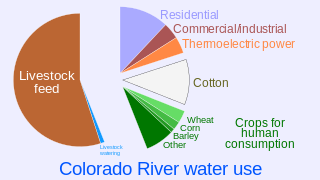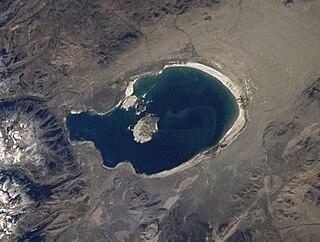Time immemorial is a phrase meaning time extending beyond the reach of memory, record, or tradition, indefinitely ancient, "ancient beyond memory or record". The phrase is used in legally significant contexts as well as in common parlance.

An acequia or séquia is a community-operated watercourse used in Spain and former Spanish colonies in the Americas for irrigation. Acequias are found in parts of Spain, the Andes, northern Mexico, and the modern-day American Southwest.

Water resources law is the field of law dealing with the ownership, control, and use of water as a resource. It is most closely related to property law, and is distinct from laws governing water quality.

A land claim is defined as "the pursuit of recognized territorial ownership by a group or individual". The phrase is usually only used with respect to disputed or unresolved land claims. Some types of land claims include aboriginal land claims, Antarctic land claims, and post-colonial land claims.
Riparian water rights is a system for allocating water among those who possess land along its path. It has its origins in English common law. Riparian water rights exist in many jurisdictions with a common law heritage, such as Canada, Australia, New Zealand, and states in the eastern United States.
Water right in water law is the right of a user to use water from a water source, e.g., a river, stream, pond or source of groundwater. In areas with plentiful water and few users, such systems are generally not complicated or contentious. In other areas, especially arid areas where irrigation is practiced, such systems are often the source of conflict, both legal and physical. Some systems treat surface water and ground water in the same manner, while others use different principles for each.

The California Department of Water Resources (DWR) is part of the California Natural Resources Agency and is responsible for the management and regulation of the State of California's water usage. The department was created in 1956 by Governor Goodwin Knight following severe flooding across Northern California in 1955, where they combined the Division of Water Resources of the Department of Public Works with the State Engineer's Office, the Water Project Authority, and the State Water Resources Board. It is headquartered in Sacramento.
United States groundwater law is that area of United States law related to groundwater.
Colorado River Water Conservation District v. United States, 424 U.S. 800 (1976), was a case in which the Supreme Court of the United States extensively refined the abstention doctrine to prevent duplicative litigation between state and federal courts.
Appropriation is a process by which previously unowned natural resources, particularly land, become the property of a person or group of persons. The term is widely used in economics in this sense. In certain cases, it proceeds under very specifically defined forms, such as driving stakes or other such markers into the land claimed, which form gave rise to the term “staking a claim.” "Squatter’s rights" are another form of appropriation, but are usually asserted against land to which ownership rights of another party have been recognized. In legal regimes recognizing such acquisition of property, the ownership of duly appropriated holdings enjoys such protections as the law provides for ownership of property in general.
Water trading is the process of buying and selling water access entitlements, also often called water rights. The terms of the trade can be either permanent or temporary, depending on the legal status of the water rights. Some of the western states of the United States, Chile, South Africa, Australia, Iran and Spain's Canary Islands have water trading schemes. Some consider Australia's to be the most sophisticated and effective in the world. Some other countries, especially in South Asia, also have informal water trading schemes. Water markets tend to be local and informal, as opposed to more formal schemes.
An easement is a nonpossessory right to use and/or enter onto the real property of another without possessing it. It is "best typified in the right of way which one landowner, A, may enjoy over the land of another, B". An easement is a property right and type of incorporeal property in itself at common law in most jurisdictions.

California's interconnected water system serves almost 40 million people and irrigates over 5,680,000 acres (2,300,000 ha) of farmland. As the world's largest, most productive, and potentially most controversial water system, it manages over 40 million acre-feet (49 km3) of water per year. Use of available water averages 50% environmental, 40% agricultural and 10% urban, though this varies considerably by region and between wet and dry years. In wet years, "environmental" water averages 61%, while in dry years it averages 41%, and can be even lower in critically dry years.
Winters v. United States, 207 U.S. 564 (1908), was a United States Supreme Court case clarifying water rights of American Indian reservations. This doctrine was meant to clearly define the water rights of indigenous people in cases where the rights were not clear. The case was first argued on October 24, 1907, and a decision was reached January 6, 1908. This case set the standards for the United States government to acknowledge the vitality of indigenous water rights, and how rights to the water relate to the continuing survival and self-sufficiency of indigenous people.

Water law in the United States refers to the Water resources law laws regulating water as a resource in the United States. Beyond issues common to all jurisdictions attempting to regulate water's uses, water law in the United States must contend with:

Water in Colorado is of significant importance, as the American state of Colorado is the 7th-driest state in America. As result, water rights generate conflict, with many water lawyers in the state.

National Audubon Society v. Superior Court was a key case in California highlighting the conflict between the public trust doctrine and appropriative water rights. The Public Trust Doctrine is based on the principle that certain resources are too valuable to be privately owned and must remain available for public use. In National Audubon Society v. Superior Court, the court held that the public trust doctrine restricts the amount of water that can be withdrawn from navigable waterways. The basis for the Public Trust Doctrine goes back to Roman law. Under Roman law, the air, the rivers, the sea and the seashore were incapable of private ownership; they were dedicated to the use of the public. In essence, the public trust doctrine establishes the role of the state as having trustee environmental duties owed to the public that are subsequently enforceable by the public. There is judicial recognition of this, dictating that certain rights of the public are key to individual common law rights. Judicial recognition of the public trust doctrine has been established for tidelands and non-navigable waterways, submerged land and the waters above them, and preservation of a public interest.
Lux v. Haggin, 69 Cal. 255; 10 P. 674; (1886), is a historic case in the conflict between riparian and appropriative water rights. Decided by a vote of four to three in the Supreme Court of California, the ruling held that appropriative rights were secondary to riparian rights.
The California Water Commission Act of 1913 was the first attempt by the legislature of the state of California to address water rights in a comprehensive manner. The Act was necessitated by the complicated landscape of competing water rights doctrines, demands for reclamation and irrigation, and tension between large landowners and smaller farmers all in the context of California's unique climate and topography. The State Water Commission created by the Act was given the responsibility of permitting and licensing water appropriators post-1914, but had no authority over pre-1914 claims. Ultimately the Act improved the recording of water rights but was inadequate to supervise the distribution of water and left many unresolved issues.
The origin of water law in California dates back to the 1848 Gold Rush and the historical event's direct effect on water law development in the region. Despite California attaining statehood in 1850, water law in the region had already been rapidly developing since January 1848 due to the resource's centrality in gold processing and mining. The foundations of the 1850s Gold Rush's water laws, initially developing in the mining camps, are still present in California's modern water code, notably in the principles within prior appropriation.








